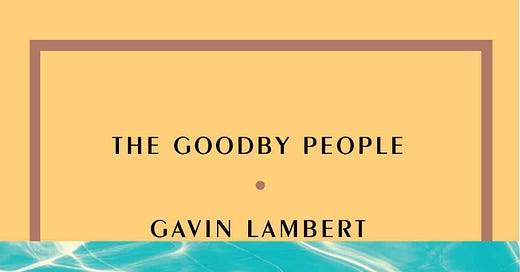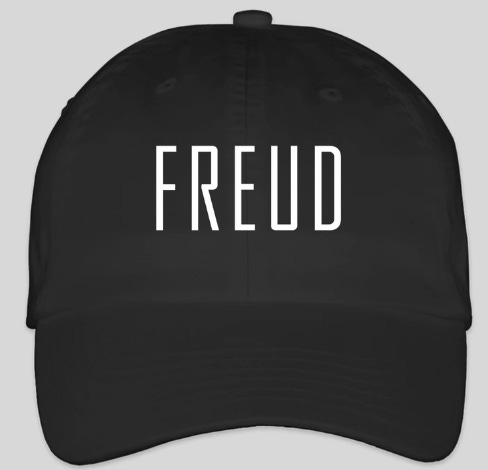The Weird, Sublime Joy of a Late-Summer L.A. Novel
Read Gavin Lambert's The Goodbye People by the pool
This is normally the time of the year when I hop on social media and remind everybody that Colson Whitehead’s Sag Harbor is the best book to read during August. I’m not not going to do that. In fact, I believe I just told you. So my work here could technically be done. But it’s not. Today, I’m going to add to the list of “Perfect Books for the Dog Days” by saying you should carve out a little time this time of the season to read a Los Angeles book. Not just a book set in L.A., but a real L.A. book. What do I mean by that? As a person not from Los Angeles, I mean the type of book that helps build up all the weird stereotypes about the place and turns them into something eerie that you can’t shake. I first realized L.A. books are perfect for late-July or August when I had a few hours to kill at a friend’s house a few years ago and saw a copy of Less Than Zero on the shelf. I figured that the Bret Easton Ellis debut was such an important book when I was younger that I should try and re-read it every few years to gain a new perspective on it. So I picked it up on some horribly muggy morning when my whole being felt like mush, and boy did that book hit me differently. Sweating like crazy and not being able to breathe well because of the poor air quality changed the experience of reading Clay being down, out, and jaded in 1980s L.A. I don’t want to say I feel like I was there, man, but visited and I watched enough movies set in La La Land during the Reagan era that I’ll always have a specific vision in my head of what it looked like then. It was hazy and hot, everything had a trippy, unreal quality to me as an outsider. I suppose that’s why I’m always fascinated with how people from L.A. perceive their hometown: I loved what Ellis did when he returned to L.A. with his last book, The Shards. Eve Babitz—of course. And when Quentin Tarantino and Paul Thomas Anderson both re-created the Los Angeles of their childhoods, I personally think they ended up making some of their best movies. (Please, I will hear no Licorice Pizza slander. Save it if you’ve got it.) I’ve also read books by James Ellroy, Darcy O'Brien, and Danny Sugerman when it was hot out, and both hit me harder than they might have in the fall or winter.
The Los Angeles transplant book gives another type of feel. Joan Didion is at the top of the list. Play It as It Lays is a perfect pool book. It’s different from a beach book because my belief when it comes to books for sitting in the sand is that you should be able to put it down and pick it back up with the same amount of ease since there’s typically more going on when you’re at the beach. There’s more to explore or you can just zone out watching the waves. When a pool is your only option, just sitting for hours with a drink or two, then taking the occasional dip, is sort of the best way to do things. Didion’s novel perfectly suits that setup, as does John Fante’s Ask the Dust. The Day of the Locust, the other big L.A. novel written by an outsider, New York boy Nathanael West, could be a pool book, but I’m not sure. I’ve read it so many times that its weirdness feels natural any time of the year. Aldous Huxley’s After Many a Summer is one of his more overlooked works, and it’s a great L.A. book, but maybe not for the pool, either. All the iconic noir books set there are.
My latest addition to the canon of late-summer L.A. books that are great for the pool is Gavin Lambert’s The Goodbye People. I picked up the 1971 novel that McNally Editions put back out into the world a few years back intending to read it with the smell of chlorine on my skin, but new parent duties have kept me from spending any time poolside this summer. I decided to read it after I was reminded this was the fifth anniversary of Tarantino’s Once Upon a Time…in Hollywood, and the jacket copy on Lambert’s book sold me on it being set in a “post-Manson, pre-Disney Los Angeles,” the city almost immediately after Tarantino’s movie made it so the Manson Family didn’t end up killing Sharon Tate and her pals. That’s the time and place Ellis always talks about as the period that had the biggest impact on him, and I find that I’ve always gravitated toward movies, books, and music made by people who were growing up in L.A. when Charlie and his family were terrorizing the city.
Lambert was a British writer who went out to Hollywood for the same reason any writer goes out there, and he did have some success with writing for movies and TV (including an Oscar nomination for the 1960 adaptation of D.H. Lawrence’s Sons and Lovers). He also wrote some biographies on Hollywood stars and the story of the making of Gone With the Wind, but his outsider eye lends itself to his fictional tales of Los Angeles life. 1963’s Inside Daisy Clover is his most successful novel, even though the 1965 film adaptation was mostly viewed as a failure at the box office and among critics. I’ve only ever seen the film, and I enjoyed it, chalking its failure up to being a victim of the time it was released. After reading The Goodbye People, I think I’m going to make Inside Daisy Clover my late-summer 2025 pool book. Or I might just re-read The Goodbye People. Anything is possible.
I was trying to describe the book to a friend the other day, attempting to avoid plagiarizing anything I read on the jacket. The best comparison I could come up with was to tell them it’s sort of like if you took the scene in Annie Hall where they’re at the party in the L.A. mansion owned by the record producer played by Paul Simon, but you kept going, exploring the city and its inhabitants, all hopped up on quaaludes and natural foods from The Source. It’s not a horror novel, but there’s something dead and creepy about it in a very L.A. way. When one woman says “I feel like I’m living in a rented universe,” it captures what some of us not from L.A. might consider stereotypical Los Angeles speak. But over 50 years since The Goodbye People was released, that line and some other parts from it feel eerily modern and relatable no matter where you live.
Other Notes
Rebecca Mead profiled Gillian Anderson. That’s exciting enough. The little tidbit that Anderson has been reading Miranda July’s All Fours is a nice little bonus.
Speaking of L.A., Lila Shapiro’s profile “Therapy Daddy” Phil Stutz is fascinating stuff. A movie star complaining about how shrinks kept him at “a massive distance” is so funny to me. That’s sort of the point, Jonah.
And speaking of therapists, I’ve been reading Parapraxis ever since I read about it in a NYT article on how the young are embracing psychoanalysis (yay!), and I’ve got to say that the merch game is strong. I went with the Freud hat because, well, Siggy is my guy. I like the Frantz Fanon one, but I feel like if you’re a white dude showing up to a bar in a hat that says Fanon in 2024 it’s sort of the new “Carrying around a copy of Infinite Jest to make sure people know you’re reading it.”





